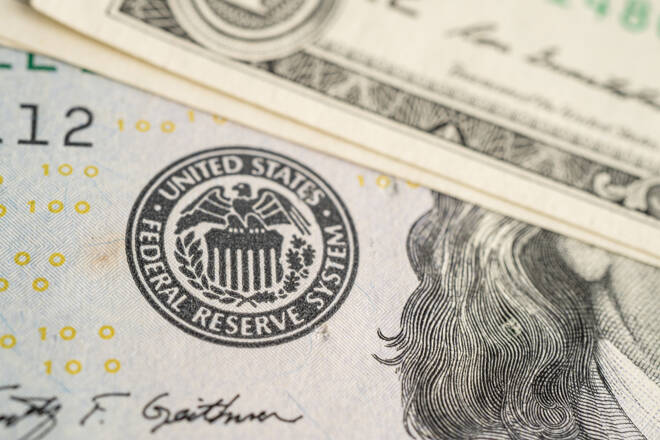Advertisement
Advertisement
US Dollar Price Forecast: DXY Rises to 103.65 After Fed Hold; BOE Policy Ahead
By:
As the US Dollar climbs to 103.650 post-Fed's rate decision, all eyes turn to the upcoming BOE policy announcement for further cues.
Highlights
- US Dollar rallies to 103.650; ADP employment falls short with Fed holding rates steady at 5.50%.
- ECB’s Lagarde and upcoming CPI data spotlighted in the Eurozone; BOE expected to maintain a 5.25% rate, influencing GBP/USD.
- Dollar Index bullish above 103.438 amidst triple top pattern; EUR/USD and GBP/USD face bearish pressure under pivotal levels.
US Dollar Strengthens; Eyes on BOE’s Rates
The US Dollar is currently exhibiting bullish behavior, trading around 103.650 with an uptick of 0.13%. Recent events have seen the ADP Non-Farm Employment Change report lower figures than expected at 107K against the forecast of 148K, juxtaposed with a steady Federal Funds Rate maintained at 5.50%.
In contrast, the EUR zone witnessed a slight uptick in the German Prelim CPI month-over-month, recording a 0.2% increase, indicative of subtle inflationary pressures.
Events Ahead
For the US, Unemployment Claims are forecasted at 213K, closely followed by the ISM Manufacturing PMI and Prices, expected at 47.2 and 46.0, respectively, painting a mixed picture of the manufacturing sector’s health and pricing pressures.
In the Eurozone, attention pivots towards ECB President Lagarde’s speech and critical inflation data with the Core CPI Flash Estimate year-over-year forecasted at 3.2%, and the CPI Flash Estimate at 2.7%, potentially signaling inflation trends and monetary policy directions.
US Dollar Index (DXY)
On February 1, the Dollar Index’s pivot point stands at 103.438, suggesting potential shifts in trading dynamics. Resistance levels are set at 103.748, 104.037, and 104.280, challenging upward movement.
Conversely, immediate support at 103.260 and further support at 102.937 and 102.658 offer buffers against declines. The 50-day and 200-day EMAs at 103.387 and 103.081, respectively, hint at a bullish sentiment.
The observation of a triple top pattern near the 103.748 level indicates strong resistance, with a breakout potentially leading to further gains. Thus, the Dollar Index’s trend appears bullish above 103.438, suggesting an optimistic outlook for the near term.
EUR/USD Technical Forecast
On February 1st, the EUR/USD pair is trading at 1.08044, marking a slight decline of 0.12% within a 24-hour frame. The currency pair’s technical outlook reveals a critical pivot point at 1.08215, setting the stage for upcoming trading dynamics. Resistance levels are identified at 1.08651, 1.08977, and 1.09317, potentially challenging upward movements.
Conversely, immediate support at 1.07810, followed by 1.07571 and 1.07249, underscores the lower boundaries that could stabilize or further pressurize the pair. The 50-day and 200-day Exponential Moving Averages (EMAs) at 1.08533 and 1.08894, respectively, currently act as ceilings for the price, hinting at a bearish sentiment.
The presence of bearish engulfing candlestick patterns below both EMAs further supports the likelihood of a continuing downtrend. Given these observations, the EUR/USD’s trajectory appears bearish below the pivot point of 1.08215, suggesting a cautious approach for traders eyeing potential entry and exit points.
GBP/USD Technical Forecast
On February 1st, the GBP/USD pair is observed at 1.26732, experiencing a modest decline of 0.12%. The technical landscape for this currency pair is defined by a pivotal point at 1.26990, guiding the day’s trading sentiment. Resistance levels are strategically placed at 1.27387, 1.27751, and 1.28139, delineating potential hurdles for upward price action.
Conversely, support is established at 1.26557, with subsequent levels at 1.26244 and 1.25975 offering a cushion against further declines. The 50-day and 200-day Exponential Moving Averages (EMAs) at 1.26994 and 1.26735, respectively, hover around the current price, suggesting a tight trading range. The GBP/USD’s ongoing consolidation between 1.2740 and 1.2650 indicates a cautious market approach.
In summary, the GBP/USD exhibits a bearish bias below the pivot point of 1.26990, underscoring a need for vigilance among traders watching for a potential shift in momentum.
For a look at all of today’s economic events, check out our economic calendar.
About the Author
Arslan Aliauthor
Arslan is a finance MBA and also holds an MPhil degree in behavioral finance. An expert in financial analysis and investor psychology, Arslan uses his academic background to bring valuable insights about market sentiment and whether instruments are likely to be overbought or oversold.
Latest news and analysis
Advertisement
